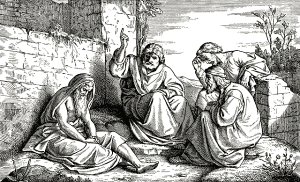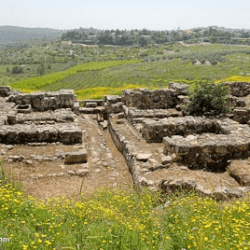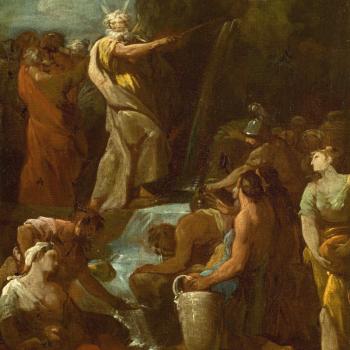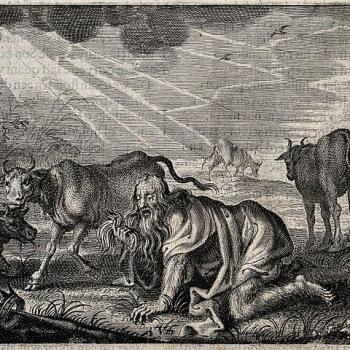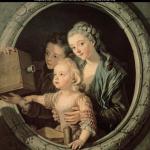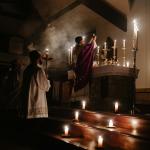Where Was Uz?
Job 1:1 (RSV) There was a man in the land of Uz, whose name was Job; . . .
Uz, according to the book, was in close proximity to the Temanites, the Shuhites, the Naamathites (all noted in Job 2:11), and the Buzites (Job 32:2), as well as possibly the Arabian Desert (1:19). Lamentations 4:21 associates Uz with Edom, which was located to the east and west of the Aravah, or Arabah, the Jordan Rift Valley between the Dead Sea and the Red Sea. This view seems to fit with the flora and fauna mentioned in the book. International Standard Bible Encyclopedia elaborates on the location of Uz:
The country was subject to raids by Chaldeans and Sabeans (Lam. 1:15, 17); . . . Job himself is called one of the children of the East (Qedhem) [Job 1:3]. The Chaldeans (kasdim, descendants of Chesed, son of Nahor, Gen. 22:22) inhabited Mesopotamia; a branch of the Sabeans also appears to have taken up its abode in Northern Arabia (see Sheba). Teman (Gen. 36:11) is often synonymous with Edom. . . . Shuah was a son of Keturah the wife of Abraham (Gen. 25:2), and so connected with Nahor. Shuah is identified with Suhu, mentioned by Tiglath-pileser I as lying one day’s journey from Carchemish; and a “land of Uzza” is named by Shalmaneser II as being in the same neighborhood. . . . Abraham sent his children, other than Isaac (so including Shuah), “eastward to the land of Qedhem” (Gen. 25:6). (1)
McClintock and Strong provide similar speculation:
As far as we can gather, it lay either east or south-east of Palestine (Job 1:3) . . .adjacent to the Sabeans and the Chaldaeans (Job 1:15, 17), consequently northward of the Southern Arabians, and westward of the Euphrates; and, lastly, adjacent to the Edomites of Mount Seir, who at one period occupied Uz, probably as conquerors (Lam. 4:21), and whose troglodytic habits are probably described in Job 30:6-7. . . . From the above data we infer that the land of Uz corresponds to the Arabia Desert of classical geography, at all events to so much of it as lies north of the 30th parallel of latitude. . . .
The general opinion of Biblical geographers and critics locates “the land of Uz” somewhere in Arabia Petraea. (2)
The New Bible Dictionary states that “Most modern scholars incline towards the more southerly location”: which it defines as “the area between Edom and N. Arabia.” (3)
Gleason Archer broadly concurs:
The district of Uz, in which the action took place, was located in northern Arabia; the Sepuagint refers to it as the land of the Aisitai, a people whom Ptolemy the geographer locates in the Arabian desert adjacent to the Edomites of Mount Seir. (4)
As to the Temanites’ association with Edom:
A duke Teman is named among the chiefs or clans of Edom (Gen. 36:42; 1 Chron. 1:53). He does not however appear first, in the place of the firstborn. Husham of the land of the Temanites was one of the ancient kings of Edom (Gen. 36:34; 1 Chron. 1:45). From Obad. 1:9 we gather that Teman was in the land of Esau (Edom). In Amos 1:12 it is named along with Bozrah, the capital of Edom. In Ezek. 25:13 desolation is denounced upon Edom: “From Teman even unto Dedan shall they fall by the sword.” (5)
The Buzites were also “probably” from “the neighborhood of Edom.” (6) Archer thinks they “probably lived adjacent to the Chaldeans in northeast Arabia.” (7)
The highest probability of the location of Uz, based on all these indications, as best can be determined by scholars, therefore, seems to be the land of Edom, or in any event on its borders or relatively close to it.
Date of the Events and Composition
All estimates are — to varying degrees — speculative and uncertain, but — for what it’s worth — Archer notes that a date “before the time of Moses, in the patriarchal age . . . was the view of the Talmud and was widely held by Christian scholars until modern times.” (8) Some conservative Bible scholars like Keil and Delitzsch, E. J. Young, and Unger thought that the composition dated to the time of Solomon (10th century B.C.), though most of them thought Job lived during the time of Moses or earlier. The broad conservative consensus might be summed up as follows: “A Solomonic date . . . is the earliest we can reasonably adopt . . . [but] any dogmatism derives from subjectivism or preconceptions.” (9)
The more traditional views as to the date of its events and the recording of them are based on the following rationales:
The story of the Book of Job is laid in the far-off patriarchal age, such a time as we find elsewhere represented only in the Book of Genesis; a time long before the Israelite state, with its religious, social and political organization, existed. . . . The patriarchal conditions, wherein the family is the social and communal unit, enable him to portray worship and conduct in their primal elements: religious rites of the simplest nature, with the family head the unchallenged priest and intercessor (compare Job 1:4-5; 42:8), and without the austere exactions of sanctuary or temple; to represent God, as in the old folk-stories, as communicating with men in audible voice and in tempest; and to give to the patriarch or sheikh a function of counsel and succor in the community analogous to that of the later wise man or sage (compare Job 29:1-25). (10)
Until a comparatively late time, the general opinion was not only that the persons and events which it describes are real, but that the very words of the speakers were actually recorded. It was supposed either that Job himself employed the latter years of his life in writing it (A. Schultens), or that at a very early age some inspired Hebrew collected the facts and sayings, faithfully preserved by oral tradition, and presented them to his countrymen in their own tongue. Some such view seems to have been adopted by Josephus, for he places Job in the list of the historical books, and it was prevalent with all the fathers of the Church. . . .
It has always seemed to pious writers incompatible with any idea of inspiration to assume that a narrative, certainly not allegorical, should be a mere fiction, and irreverent to suppose that the Almighty would be introduced as a speaker in an imaginary colloquy.
We are led to the same conclusion by the soundest principles of criticism. Ewald says (Einl. p. 15) most truly, “The invention of a history without foundation in facts — the creation of a person, represented as having a real historical existence, out of the mere head of the poet — is a notion so entirely alien to the spirit of all antiquity, that it only began to develop itself gradually in the latest epoch of the literature of any ancient people, and in its complete form belongs only to the most modern times.” In the canonical books there is not a trace of any such invention. Of all people, the Hebrews were the least likely to mingle the mere creations of imagination with the sacred records reverenced as the peculiar glory of their race.
It is true that the arguments advanced by Ewald (11) to show the historical character of the chief features of the book are not entirely conclusive, . . . still they must be allowed to have some weight, and, taken in connection with the general usage of Scripture in its poetical and rhetorical amplifications, and especially with the considerations presently to be adduced in relation to the author of this. book, justify the presumption of a historical foundation, not only for the facts and personages represented in the book, but also, to a certain extent, for the speeches. . . .
To this it must be added that there is a singular air of reality in the whole narrative, such as must either proceed naturally from a faithful adherence to objective truth, or be the result of the most consummate art. (12)
Many look upon the entire contents of the book as a freely invented parable which is neither historical nor intended to be considered historical; no such man as Job ever lived. Catholic commentators, however, almost without exception, hold Job to have actually existed and his personality to have been preserved by popular tradition. Nothing in the text makes it necessary to doubt his historical existence. The Scriptures seem repeatedly to take this for granted (cf. Ezekiel 14:14; James 5:11; . . .). All the Fathers considered Job an historical person; . . . The Book of Job, therefore, has a kernel of fact, with which have been united many imaginative additions that are not strictly historical. What is related by the poet in the prose prologue and epilogue is in the main historical: the persons of the hero and his friends; the region where be lived; his good fortune and virtues; the great misfortune that overwhelmed him and the patience with which he bore it; the restoration of his Prosperity. . . .
According to the usual and well-founded assumption, Job lived long before Moses. . . . His wealth like that of the Patriarchs, consisted largely in flocks and herds (1:3; 42:12). The kesitah or piece of money mentioned in 42:11, belongs to patriarchal times; the only other places in which the expression occurs are Genesis 33:19, and Joshua 24:32. The musical instruments referred to (21:12; 30:31) are only those mentioned in Genesis (Gen. 4:21; 31:27): organ, harp, and timbrel. Job himself offers sacrifice as the father of the family (1:5), as was also the custom of the Patriarchs. . . .
Job evidently did not belong to the chosen people. He lived, indeed, outside of Palestine. He and the other characters betray no knowledge of the specifically Israelitic institutions. Even the name of God peculiar to the chosen people, Yahweh, is carefully avoided by the speakers in the poetic part of the book, and is only found, as if accidentally, in 12:9, and according to some manuscripts in 28:28. The sacrifice in 42:8, recalls the sacrifice of Balaam (Numbers 23:1), consequently a custom outside of Israel. For the solution of the problem of suffering the revelations made to the Patriarchs or even Moses are never referred to. Nevertheless Job and his friends venerated the one true God. They also knew of the Flood (22:16), and the first man (15:7, and Hebrews 31:33). . . .
The author of the book is unknown, neither can the period in which it was written be exactly determined. Many considered the book the work of Job himself or Moses. It is now universally and correctly held that the book is not earlier than the reign of Solomon. (13)
Timnah Copper Mines
Job 28:1-3 “Surely there is a mine for silver, and a place for gold which they refine. Iron is taken out of the earth, and copper is smelted from the ore. Men put an end to darkness, and search out to the farthest bound the ore in gloom and deep darkness.”
The Timnah Copper Mines were just north of Eilat, in Edom. The current town of Eilat is on the north shore of the Gulf of Aqaba, at the southern tip of Israel. Excavations at Timna starting in 2009, led by Dr. Erez Ben-Yosef, determined with high precision dating techniques, that the major smelting activity occurred in the early Iron Age (11th–9th centuries B.C.). (14)
Coral
Job 28:18 No mention shall be made of coral . . .
Coral has been found in the excavations at the Timnah Copper mines. They came from — arguably — some of the most beautiful coral reefs in the world, in Gulf of Aqaba (the northeastern portion of the Red Sea). In fact, Eilat’s Coral Beach Nature Reserve and Conservation area is an Israeli nature reserve and national park near the city of Eilat, covering a third of a mile of shoreline. It’s the northernmost shallow water coral reef in the world. If the writer of Job knew about it the coral found there, this may indicate that he lived (and/or the events occurred) either in the century before Solomon, or in David or Solomon’s time. But it does line up with what we know. The Red Sea and things connected with it are mentioned in Job 6:3; 7:12; 9:8, 26; 12:8; and 26:12. The only other times the word “coral” appears in the entire Bible are in Lamentations 4:7 (14 verses before the text mentions Edom and Uz), and Ezekiel 27:16, where it is said to come from Edom.
Animals in Edom / Uz
The Hai Bar (Yotvata) Biblical Wildlife Reserve, also near Eilat, was founded in 1968 by Avraham Yoffe, in order to provide a refuge for and preservation of animal species indigenous to the region in ancient times. Thus, animals can be seen there which are mentioned in the book of Job: donkeys (Job 6:5; 11:12; 24:3, 5; 39:5), mountain goats (aka ibex: 39:1-4), deer (39:1; “hinds” in RSV); cobras and vipers (20:14-16); jackals (30:29); ostriches (30:29; 39:13-18); hawks (39:26); eagles (9:26; 24:3; 39:27), oryx or wild ox (39:9-12), and locusts (39:20). The book of Job also mentions the leviathan (41:1-34), thought by “most scholars” (15) to refer, in this passage, to a crocodile: an animal that used to be prevalent in Israel, even in the last few centuries, but no longer is. (16) People in Bible times were also familiar with the crocodile of the Nile. As for the behemoth (Job 40:15-24), “the hippopotamus . . . seems to fit the description best.” (17) It was definitely known in ancient Egypt, and remains from the fourth and third millennia B.C. have been found in the Sinai Peninsula and near present-day Tel Aviv. They are thought to have become extinct in the Levant sometime after the ninth century B.C. (the same being true of elephants). (18)
Additionally, Yehuda Feliks, a professor of Biblical and Talmudic Botany, in his book, Nature and Man in the Bible: Chapters in Biblical Ecology (London: Soncino Press, 1981) provides numerous examples of plants mentioned in the book of Job: indigenous to the regions of Uz and Edom.
FOOTNOTES
1) James Orr, ed., International Standard Bible Encyclopedia, (Grand Rapids, Michigan: Wm. B. Eerdmans Publishing Co., 1939), “Uz (2)”.
2) John McClintock and James Strong, eds., The Cyclopedia of Biblical, Theological, and Ecclesiastical Literature (New York: Harper and Brothers: 1880), “Uz.” Arabia Petraea was the name of a province of Rome, consisting of the former Nabataean Kingdom in Jordan, the southern Levant, the Sinai Peninsula, and the northwestern portion of the Arabian Peninsula. Its capital was Petra. Ancient Edom was within its boundaries.
3) J. D. Douglas, ed., The New Bible Dictionary (Grand Rapids, Michigan: Wm. B. Eerdmans Publishing Co., 1962), “Uz,” 1306.
4) Gleason L. Archer, Jr., A Survey of Old Testament Introduction (Chicago: Moody Press, 1964), 440
5) Orr, “Teman.”
6) Orr, “Buz; Buzi; Buzite.”
7) Archer, 440.
8) Archer, 442.
9) Douglas, “Job, Book of,” 636. My own opinion (based on the research of Egyptologist and archaeologist Kenneth Kitchen) is that Abraham was born c. 1880-1860 B.C., Joseph was born c. 1737-1717 B.C., and that Moses lived from c. 1340 or 1330-c. 1220 or 1210 B.C.
10), Orr, “Job, Book of.”
11) Georg Heinrich August Ewald (1803-1875) was a German Protestant theologian and exegete; a professor of theology and of oriental languages.
12) McClintock and Strong, “Job.”
13) Joseph Hontheim, “Job,” in The Catholic Encyclopedia (New York: Robert Appleton Company; this article, 1910). The nomenclature for Bible citations has been updated.
14) Erez Ben-Yosef et al, “A New Chronological Framework for Iron Age Copper Production at Timna (Israel),” Bulletin of the American Schools of Oriental Research No. 367 (August 2012), 31-71.
15) Douglas, “Leviathan,” 1029.
16) See Arik Haglili, “Crocodiles in Israel.”
17) Douglas, “Behemoth,” 138.
18) Reginald O’Donoghue, “Beasts of the Bible and Babylon,” The Extinctions, July 24, 2021.
***
Practical Matters: Perhaps some of my 4,200+ free online articles (the most comprehensive “one-stop” Catholic apologetics site) or fifty-one books have helped you (by God’s grace) to decide to become Catholic or to return to the Church, or better understand some doctrines and why we believe them.
Or you may believe my work is worthy to support for the purpose of apologetics and evangelism in general. If so, please seriously consider a much-needed financial contribution. I’m always in need of more funds: especially monthly support. “The laborer is worthy of his wages” (1 Tim 5:18, NKJV). 1 December 2021 was my 20th anniversary as a full-time Catholic apologist, and February 2022 marked the 25th anniversary of my blog.
PayPal donations are the easiest: just send to my email address: apologistdave@gmail.com. You’ll see the term “Catholic Used Book Service”, which is my old side-business. To learn about the different methods of contributing, including 100% tax deduction, etc., see my page: About Catholic Apologist Dave Armstrong / Donation Information. Thanks a million from the bottom of my heart!
***
Photo credit: Job is Visited by Three Friends [public domain / creazilla]
***
Summary: I provide examples in the book of Job of verifiable historical peoples and lands, & also note accurate mentions of copper, coral, and various indigenous animals.


